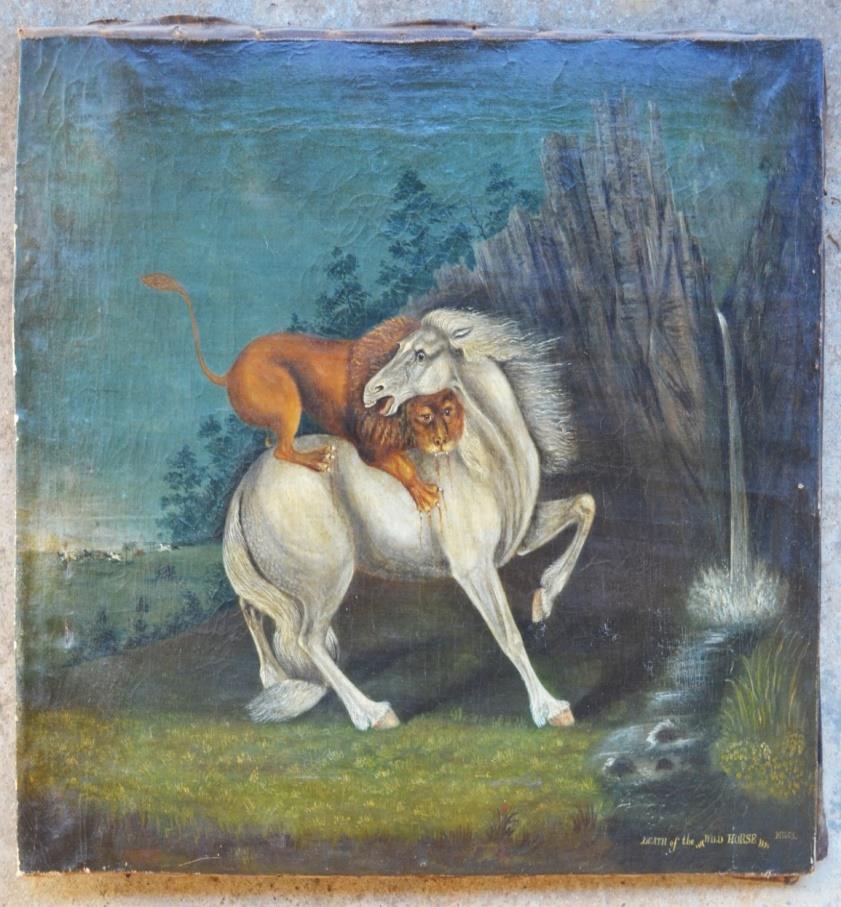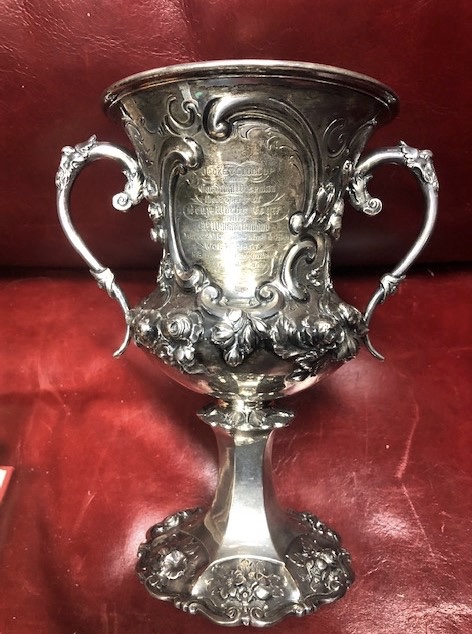1
Henry Miles’ Death of the Wild Horse
Oil on canvas, c 1875 – 1885. 50.5 cm x 63.5 cm
Englishman Henry Miles (1813–1900) was the Pound Keeper at North Rhine (in the Angaston district at the southern end of the Barossa Valley) from at least August 1854 to December 1876, managing lost and stolen animals.
He married Mary Ann Winter from Somerset in 1853 at Gawler River. Self-taught, all his artwork was completed with his left hand due to a disability. At the Royal Adelaide Show in 1874 and 1876 he was reported to have exhibited paintings of sheep and cattle owned by John Angas of Collingrove, the historic Angaston property.
The owner purchased it 25 years ago assuming it was a naïve ‘mirror image’ copy of one by Englishman George Stubbs (1724-1806) who produced 17 paintings and engravings of the scene.
It’s an epic choice of subject for Miles, incorporating anatomical understanding of the two animals as well as themes of heroic action, drama and sentiment.
Editor: So where did Miles see the original? Stubbs
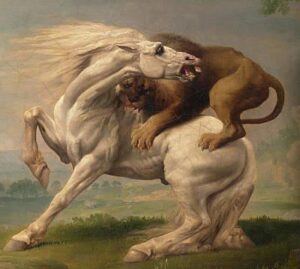
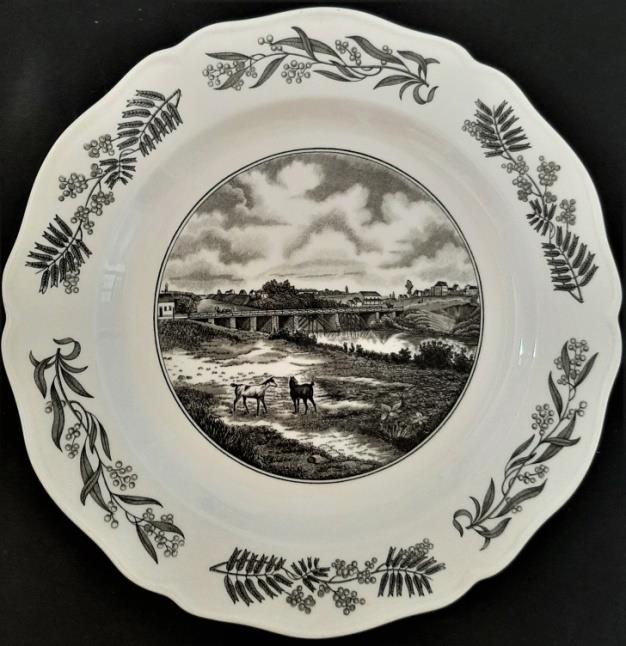
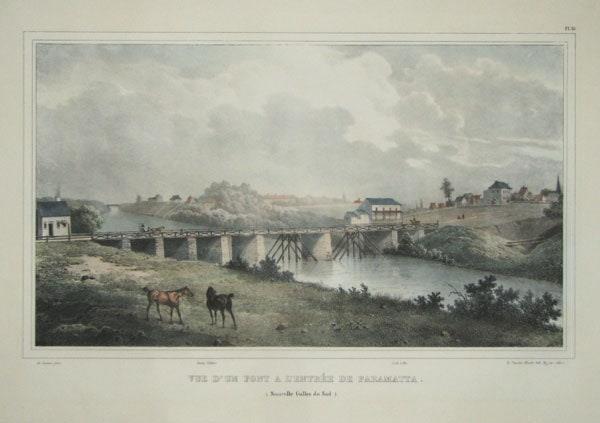
2
Wedgwood plate, Second Parramatta Bridge
After de Sainson, lithograph from sketches of first voyage of Dumont D’Urville, Voyage de la corvette l’Astrolabe, published Paris 1833, plate33. Diameter:25.5cm
Plate with transfer-printed decoration of Parramatta’s second bridge 1826, by Wedgwood UK for retail store David Jones 1962. One of a set of four limited edition historical plates comprising the lighthouse at Watson’s Bay, the bridge at Parramatta, the entrance to Sydney Cove and Government House. Another set of Melbourne scenes Como, Government House, Princes Bridge and Bourke St 1878 was made for retailer Myer.
This wooden Gaol bridge was constructed on the same site as the later 1837 Lennox bridge and had a crossing span at Church Street which gave access between the town and the gaol. It also helped to open up access to the growing settlements to the north of Parramatta River.
The decking of the bridge was supported on ten sandstone piers. It was of timber and included a guard-rail or balustrade on either side that comprised drop posts with top and bottom rails with each section infilled with timber diagonals.
Floodwaters in 1826 severely damaged three of the piers and, with one being rebuilt in late 1827, the bridge managed to survive until the late 1830s when the stone Lennox bridge (still standing) was completed.
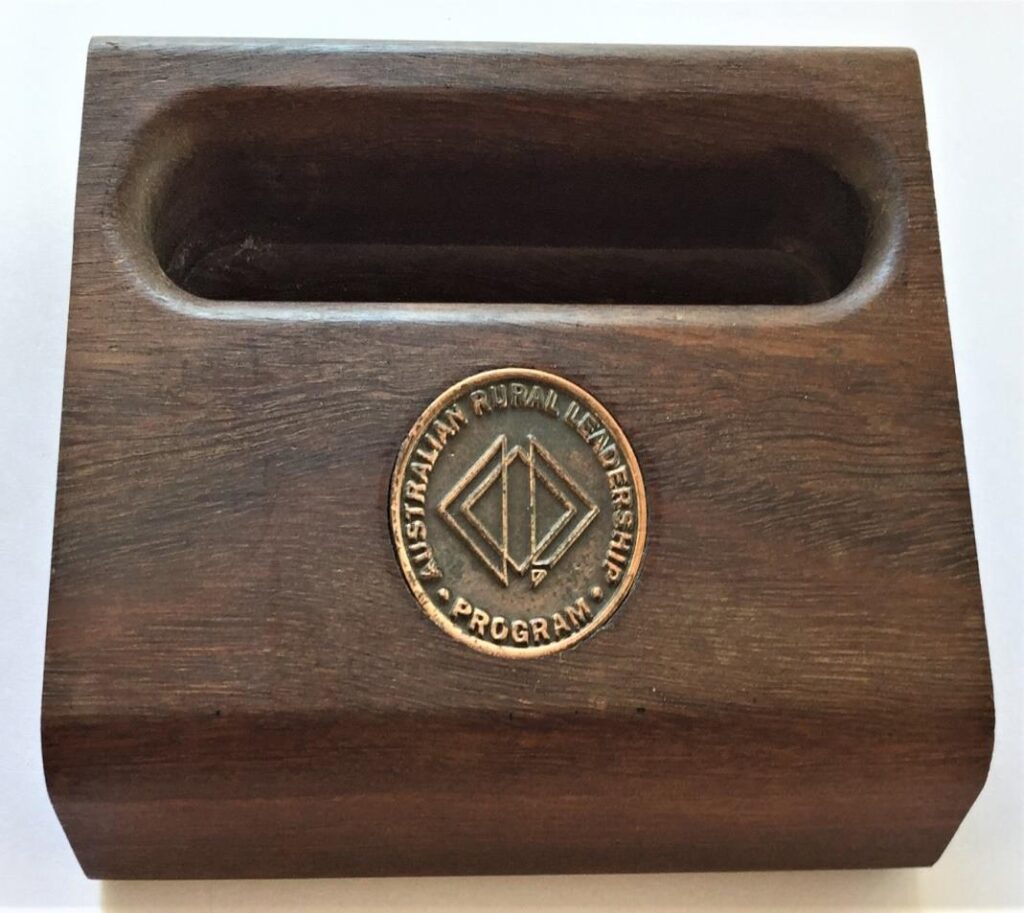
3
Jarrah Business Card Holder
Written in black ink on the underside is ‘In Appreciation / Jarrah / ARLP / Canberra / Australia’. The inset copper. Size: 11.5 x 8.5 x 3.5 cm
The Australian Rural Leadership Program (ARLP) is a not-for-profit organisation established in 1992 with the aim to develop leaders for rural, regional and remote Australia. Clients include sheep meat and rice growers’ associations and Torres Strait programs for women and young leaders.
These leaders could influence change across organisations, industries as a whole, and rural
communities in general. This presentation was to a staff member or a donor. Jarrah is a hardwood native to Western Australia.
Editor’s comments: The owner is now focusing on collecting maps of Australia that acknoweldge the existence of Tasmania – They are much rarer!
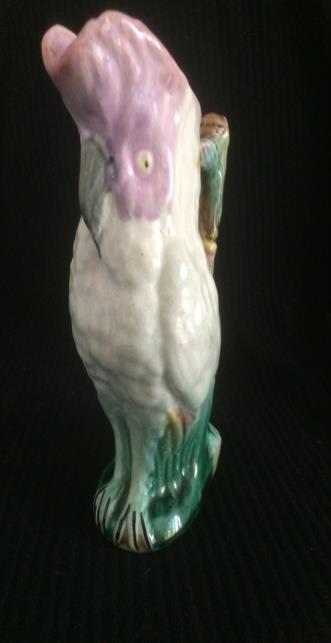
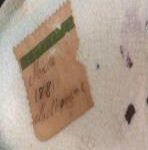
4
Majolica Parrot Jug
Size: height 18.5 cm, base 11 cm
Majolica is an earthenware pottery decorated with a clear lead glaze and is characterised by vivid colour and a high gloss finish.
Dozens of these jugs were made in the UK (Alloa, Thomas Forester) using similar glaze colours as this item.
We can only describe this jug as ‘an oddity’ and cannot confirm if it is made in 1881 or in Australia; experts suggest that was early days in attributing/ confirming colonial Australian majolica.
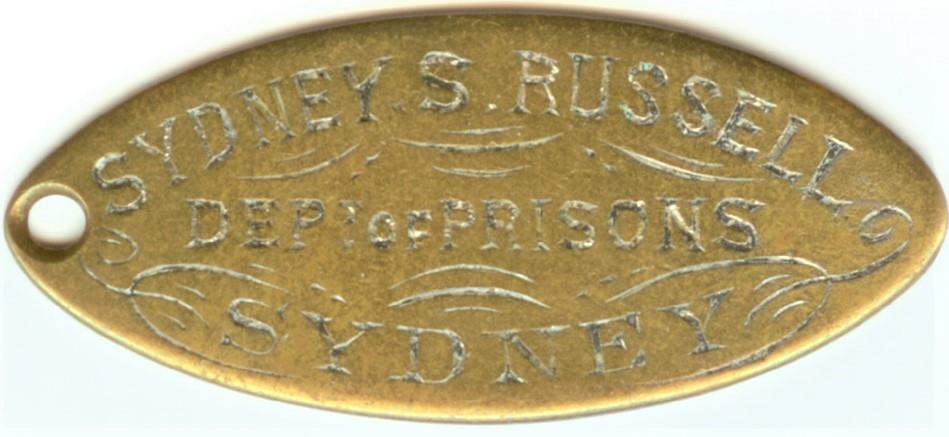
5
Sydney Department of Prisons’ Key Tag
Inscribed: SYDNEY S. RUSSELL DEPT. OF PRISONS SYDNEY. reverse blank c 1879-1905
The original owner of the key ring tag was Sydney Septimus Russell who age 39, joined the Comptroller-General of Prisons Office as a junior clerk in May 1879. He was promoted to third clerk in 1887.
The Comptroller-General of Prisons’ Department kept financial records of the state’s prisons, including the condition of the buildings. They also kept records of the number of prisoners, their behaviour as well as training programs they may have attended.
NSW established its first Department of Prisons in 1874. During the time Russell worked for the Department its heads were Harold Maclean, George Miller and William Neitenstein. The department changed its name in 1970 to Corrective Services.
At the time of Russell death in January 1932, he and his wife Minnie lived at 26 Pacific Street, Manly.
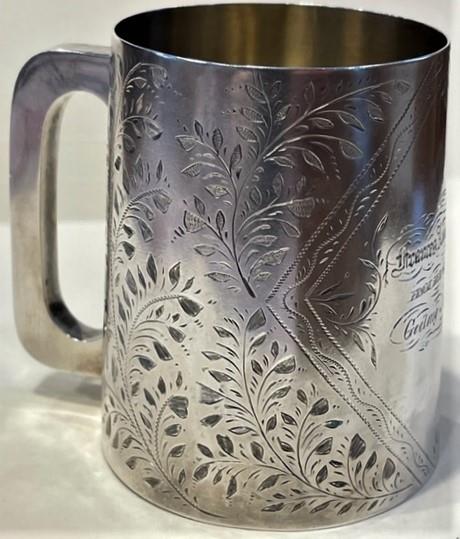
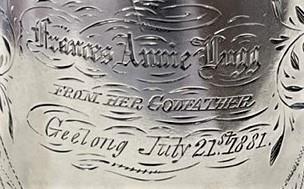
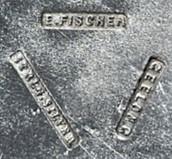
6
Christening Mug by Edward Fischer Geelong
Inscribed: ‘Frances Annie Lugg from her Godfather Geelong July 21st 1881’. Sterling silver. Base 70 cm diam, height 8.6 cm, weight 140 g
Edward Fischer (1828–191; see VS&T 15 for further information), dominated the jewellery trade in Geelong up until 1891.
Frances Annie Lugg born Geelong 1875, and married Philip Charles Holmes Hunt (1874– 1941), ADB volume 9, at Christ Church, South Yarra on 16 April 1907.
Hunt, a gas engineer from England, arrived in Melbourne in 1902 to take up a position at the Metropolitan Gas Co. He introduced slot meters, making gas affordable to Melbourne’s working class.
After visiting Europe in 1910 to investigate new carbonizing plant, he recommended and supervised impressive construction and developmental projects, including in 1912 Australia’s first vertical retort installation. The acknowledged leader of the gas industry in Australia, Hunt acted as consultant to the Australian Gas Light Co., Sydney, the South Australian Gas Co., the Hobart Gas Co., and the Newcastle Gas and Coke Co.
His wife Frances pre-deceased him in 1940.
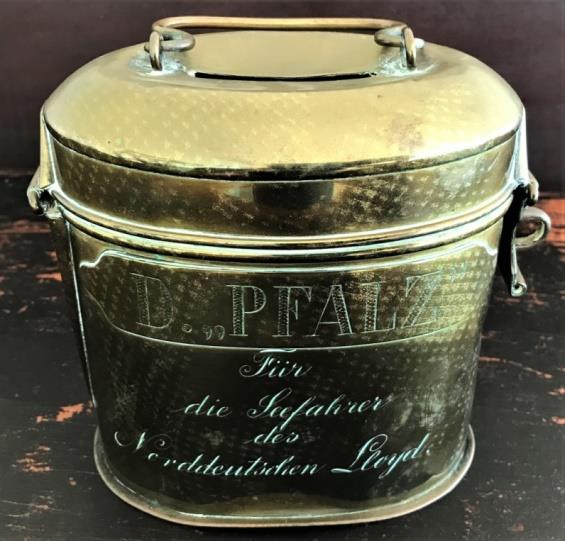
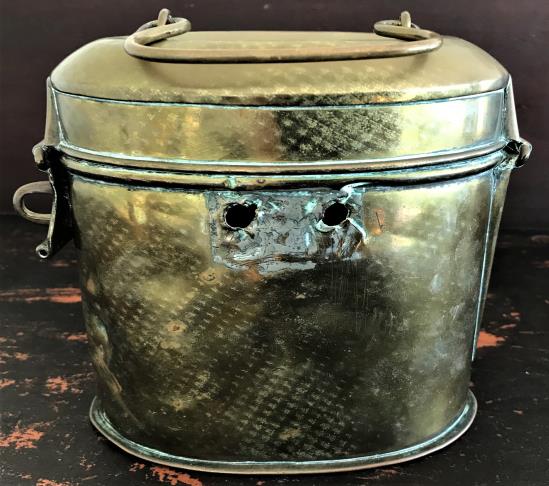
7
SS Pfalz Charity Box
Inscribed (translation): For the seafarer of North German Lloyd [shipping line], Brass c 1912 H 15cm,W 16cm
A family mystery is how did this box come into the possession of a member’s grandfather, Captain W.C. Logan?
The German cargo ship SS Pfalz was in Victoria Docks Melbourne in early August 1914 to discharge a load of newsprint and take on a load of coal. As the ship departed from Port Phillip Bay on the morning of 5 August, with German consular staff hiding on board, war was officially declared. One of the six inch guns at Fort Nepean fired a shot towards the SS Pfalz and the ship was ordered to halt and return. The consular staff and the crew were captured and dispatched to an internment camp.
SS Pfalz was hastily converted to a troop ship, renamed HMT Boorara and sailed with the second AIF convoy in December.
This was Australia’s first battle honour, and probably the only shot fired in Australia for the duration of WWI.
Editor’s comments: The press at the time got its information from the pilot of the German ship, who made most of it up. That all changed in 2012 with the discovery of a cardboard box full of military documents.
The shot had to be fired from the gun in the bay before the enemy ship got too close to Swan Island, which had a naval mine depot. If the shell missed the ship and landed there, there was a chance there could have been an explosion in the mine depot itself, or a little further on that it could hit the township of Queenscliff.
The gun commander in the bay decided on his own volition to fire the gun. The ship was halted and detained, making this not just the first event of World War I, but one of the first captured German assets in Australia.
Wounded and repatriated Gallipoli veteran Captain Whitmore Charles Logan of 2nd Light Horse re-enlisted in the Sea Transport Service February 1917 and travelled to the Suez Canal on HMT Boorara, connection solved!
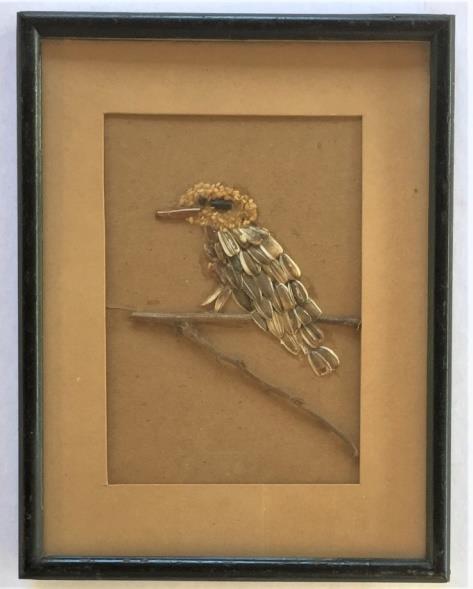
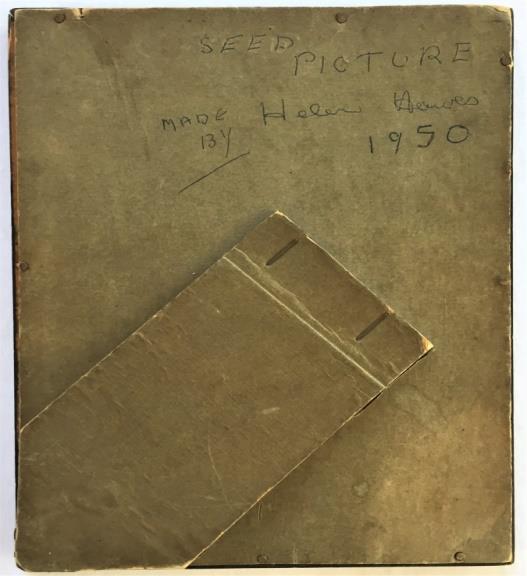
8
Kookaburra Seed Picture
Inscribed: “SEED PICTURE made by Helen Howes 1950”. Frame 22 cm x 17 cm
The kookaburra formed from seeds and sitting on a twig was probably created by a young girl.
A search in TROVE on-line newspapers, failed to identify the maker however this modest item was probably made by a South Australian as it was acquired from a shop in that state.
Many children made Christmas gifts for their parents, and still do and this art work was probably one such gift. Current craft websites suggest making seed pictures for children’s art and craft activities.
Question: If you can identify the seeds used to create this picture please advise the editors.
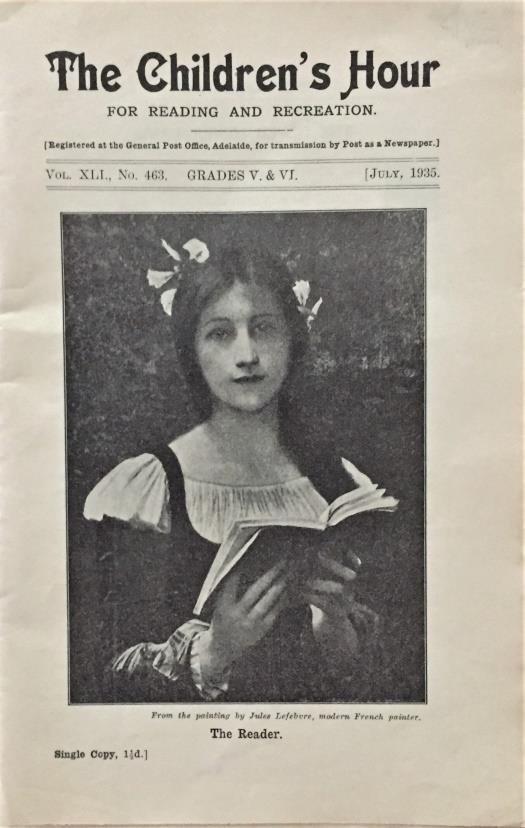
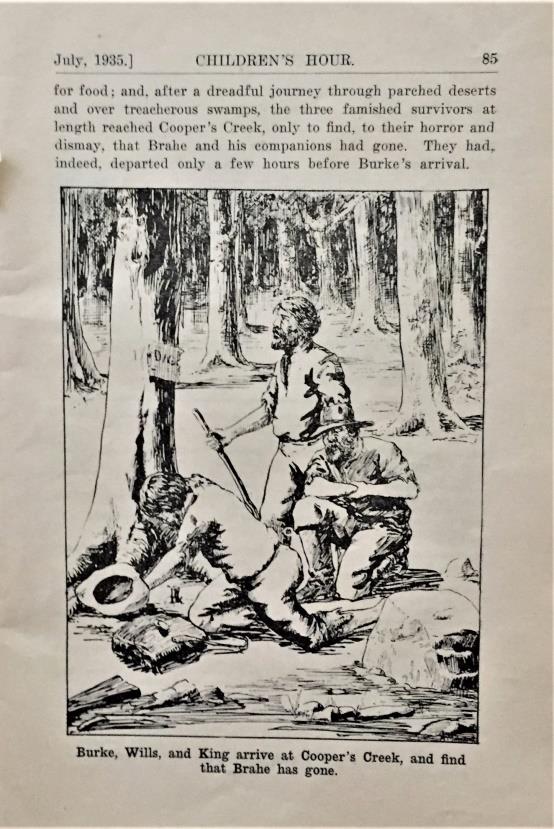
9
The Children’s Hour Magazine
Vol. XLI., No 463. Grades V & VI July 1935 Size: 22 x 14cm
The above edition contains 12 pages. The magazine was published for the Education Department of South Australia, from 1889 to the end of 1952.
In 1950 a braille version of The Children’s Hour was made available to blind children at Townsend House.
The magazine was intended for supplementary reading and recreation, supplying impeccably written up-to-date information on current events appropriate to schoolchildren, with an emphasis on patriotism and good citizenship, as well as stories, plays and poems, often introducing unfamiliar words to extend the child’s vocabulary.
Also included were a pot-pourri of jokes, puzzles and anecdotes of an “improving” nature. The editors were the source of most material and inclusion of contributions by schoolchildren was exceedingly rare.
Other states had similar magazines for school children.
10
Simpson’s Gloves, Melbourne
The Convict Slave Girls by B Earnshaw
The editors love feedback so we were delighted to hear from our sewing consultant NK, who pointed out that Museums Victoria has the Simpson’s Gloves Collection.
The factory manufactured gloves from 1924, which pre-dates that of A.W. Hansor in Chippendale NSW, claimed to be the first glove manufacturer in in Australia in 1932 in VS&T15.
The Museums Victoria collection comprises over 1200 items acquired in 1989 from the factory and head office of Simpson’s Gloves Pty Ltd at 488–496 Victoria St, Richmond.
The collection consists of machinery, tools of trade, workbenches and furniture, product samples, trade literature, photographs and signs.
Simpson’s Gloves Pty Ltd was formed in 1924 and produced leather gloves and coats, handbags, helmets and associated leather goods. The company first operated in Smith Street, and subsequently Alexandra Parade, Collingwood, relocating to Victoria Street, Richmond in 1928.
Cooee
Call for Australiana Volunteers
We need 10 articles every 2 months
Tell us about your items: humble or valuable
Tell your children you answered the call in the hour of need! Do your Bit
Editorial Team
Peter Lane pnj.lane@bigpond.com Yvonne Barber ypbarber@hotmail.com
Consultants:
Bob Fredman- Furniture
Nicola Kissane all matters relating to Sewing.
To join the editorial team or submit an item for the VS&T Report, please contact Peter at pnj.lane@bigpond.com
